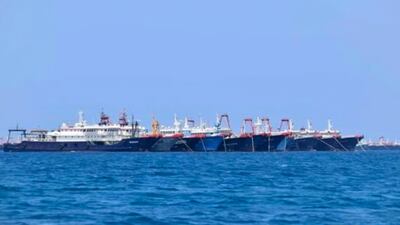The Philippine government expressed concern after spotting more than 200 Chinese fishing vessels at a reef claimed by both countries in the South China Sea.
It did not immediately lodge a protest.
A government body overseeing the disputed region said late on Saturday that about 220 Chinese vessels were seen moored at Whitsun Reef on March 7. It released pictures of the vessels lying side by side in one of the most hotly contested areas of the strategic waterway.
The reef, which Manila calls Julian Felipe, is a boomerang-shaped and shallow coral region about 324 kilometres west of Bataraza town in the western Philippine province of Palawan. It is well within the country’s exclusive economic zone, over which the Philippines “enjoys the exclusive right to exploit or conserve any resources”, the agency said in a statement.
The large numbers of Chinese boats are “a concern due to the possible overfishing and destruction of the marine environment, as well as risks to safety of navigation”, it said, although it added that the vessels were not fishing when sighted.
When asked if the Philippines would file a protest, Foreign Secretary Teodoro Locsin Jr tweeted, “only if the generals tell me”.
Chinese embassy officials did not immediately issue any comment. China, the Philippines and four other governments have been locked in a tense territorial standoff over the resource-rich and busy waterway for decades.
Critics have repeatedly called out President Rodrigo Duterte, who has nurtured friendly ties with Beijing since taking office in 2016, for not standing up to China’s aggressive behaviour and deciding not to immediately seek Chinese compliance with an international arbitration ruling that invalidated Beijing’s historic claims to virtually the entire sea. China has refused to recognise the 2016 ruling and continues to defy it.
The arbitration body also ruled that China breached its duty to respect the traditional fishing rights of Filipinos when Chinese forces blocked them from Scarborough Shoal off the north-western Philippines in 2012. The Philippines, however, could also not deny Chinese fishermen access to Scarborough, according to the ruling. The decision did not specify any other traditional fishing areas within the Philippines' exclusive zone where fishermen from China and other countries could be allowed to fish.
“When Xi says ‘I will fish,’ who can prevent him?” Mr Duterte said two years ago as he defended his nonconfrontational approach, referring to Chinese President Xi Jinping.
“If I send my marines to drive away the Chinese fishermen, I guarantee you not one of them will come home alive,” Mr Duterte said, adding that diplomatic talks with Beijing allowed the return of Filipinos to disputed fishing grounds where Chinese forces had previously driven them away.
Mr Duterte has sought infrastructure funds, trade and investment from China, which has also donated and pledged to deliver more Covid-19 vaccines as the Philippines faces a spike in coronavirus infections.

